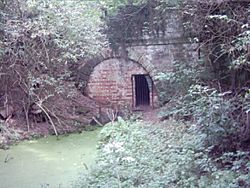Berwick Tunnel facts for kids
 |
|
| The north portal of the tunnel | |
| Overview | |
|---|---|
| Location | Shrewsbury |
| Coordinates | 52°42′4.97″N 2°41′22.22″W / 52.7013806°N 2.6895056°W |
| Status | Closed |
| Waterway | Shrewsbury Canal |
| Operation | |
| Owner | British Waterways |
| Technical | |
| Design engineer | Josiah Clowes |
| Length | 970 yards (887.0 m) |
| Width | 10 feet (3.0 m) |
| Towpath | Yes, Removed 1819 |
The Berwick Tunnel is an old canal tunnel located in Shropshire, England. It was once a very important part of the Shrewsbury Canal, helping to move goods like coal across the country.
The Story of Berwick Tunnel
The Shrewsbury Canal was built to connect the town of Shrewsbury with the Wombridge Canal. Its main purpose was to bring coal to the people of Shrewsbury at a good price. The canal route was mostly flat, but it did have some challenges. For example, there were nine locks and a big inclined plane (a slope for moving boats) needed to reach the Wombridge Canal.
The canal also had to cross two rivers, the River Tern and the River Roden. It did this using special bridges called aqueducts. One of these, the Longdon-on-Tern Aqueduct, was thought to be the first aqueduct made of cast iron. Another challenge was a hill near River Severn in Shrewsbury. A large park had been built there, so the canal couldn't go around the hill. This meant a tunnel was needed!
Building the Tunnel
Josiah Clowes was the engineer who designed the Berwick Tunnel. He worked on the canal from the very beginning until he passed away in 1795. The tunnel was about 10 feet (3.0 m) wide.
A special feature of this tunnel was its towpath. A towpath is a path next to a canal where horses or people would walk to pull boats. This tunnel was the first ever to have a towpath running all the way through it! The wooden towpath was about 3 feet (0.9 m) wide and was attached to the tunnel wall. Even though the towpath took up some space, the water still filled the entire width of the tunnel, which helped boats move through more easily.
The Berwick Tunnel is about 970 yards (890 m) long. It runs southeast from Shrewsbury, going under fields and a wood. There's a ventilation shaft (a hole for air) near the middle because the ground above is not very deep. Most of the tunnel is lined with bricks. The entrances, called portals, are made of stone. The southeast portal even has the year 1797 carved into it, showing when it was finished.
Life in the Tunnel
In 1819, the towpath was removed from the tunnel. After this, boats had to be moved through the tunnel by a method called "legging." This meant people would lie on their backs on the boat and use their feet to push against the tunnel walls or roof to move the boat forward. It sounds like hard work!
Because the tunnel isn't straight, boat crews couldn't see if another boat was coming from the other end. To solve this, a special rule, called a byelaw, was made. It said that the boat that reached the middle of the tunnel first got to continue, and the other boat had to turn back.
Berwick Tunnel Today
Today, the Shrewsbury Canal is no longer used for boats. The Berwick Tunnel is still there, but its ends have been bricked up. It stands as a reminder of the important role canals played in moving goods long ago.

